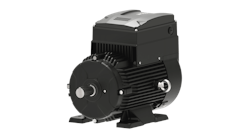Pizza well done: Anti-scale adds to coal-fired excellence
With natural gas running full tilt, coal seems to be losing some of its traction in the electric power generation business. But, the solid fuel has gained some ground in the restaurant industry, even if only on a small scale.
In 2002, Anthony Bruno, founder of Anthony’s Coal Fired Pizza (ACFP), set out to rival the taste of pizza he recalled while growing up in Long Island, N.Y. Anthony’s first coal-fired oven was built in southern Florida. Now there are 40 locations in six states along the East Coast. His 800° F ovens need only four minutes to bake pizzas to perfection, fueling the young company’s growth in short order.
Hold the salt
While Bruno’s love of artisan pizza means that natural coal will always have a role at his restaurants, he wanted to find an alternative to another natural substance: Salt. Not table salt, but rather water softener salt required to keep his fixtures free of scale.
South Florida — and most of the East Coast, for that matter — isn’t blessed with soft water. Although the degree of hardness varies from one ACFP location to another, all have challenges with hard water scale. Water is considered “moderately hard” at 4 to 6 grains per gallon (gpg), and from 7 to 10 it’s considered “hard.” Bruno’s restaurants were seeing levels up to 18 gpg.
Until this past spring, ACFP locations dealt with hard water by using salt-based, commercial water softening systems. The units not only consume a large amount of salt and discharge hundreds of gallons per month to drain through backwash and regeneration, but require a service contract and an equipment rental fee.
Though softeners were employed to address the negative effects of hard water, scale buildup was still an issue — even with increased brine adjustments. The restaurants’ utility costs were high because of the brine cycle back-washing. Large volumes of water were being consumed and sent back to the utility — all at substantial cost.
After using water softeners for more than 10 years, ACFP’s Director of Construction Thomas Williams sat down with their go-to mechanical systems resource to figure out what alternatives there might be.
“We take care of Anthony’s plumbing and air conditioning needs at the 17 locations within our territory,” says Owner John Lipka with E.H. Whitson. “But, the existing water softeners belong to a third-party company.”
Since 1936, E.H. Whitson has served South Florida’s air conditioning, plumbing and electrical needs. With 20 trucks on the road, they are no stranger to the water issues in southern Florida.
“Lipka asked me if there was an alternative to the salt-based systems that they were using at the time,” recalls Rick Sharp, sales manager at Lion Plumbing Supply. The company distributes a large variety of plumbing and water treatment products between Palm Beach and Key West. “After collecting flow rate information, I sent him a template-assisted crystallization (TAC) anti-scale system.”
Sharp and Lipka have worked closely since Sharp started with Lion Plumbing Supply in 1986. It’s formed a trusting wholesaler-installer relationship that pays off in situations like this; even though Lipka wasn’t familiar with the new technology, he knew installing it wouldn’t be a mistake.
How it works
The TAC system that Sharp specified would address all three of the issues that ACFP restaurants were trying to resolve: Salt use, equipment rental and service, high utility costs and ineffective scale prevention. Its primary goal is to reduce the negative effects of water hardness (calcium carbonate) in plumbing systems, appliances and other components. The TAC system also eliminates the use of chemical additives, doesn’t create wastewater and results in zero pollution while minimizing installation and maintenance costs. It also uses zero electricity.
TAC media starts out as polymeric beads (resin) roughly the size of some powdered laundry detergents. Catalytically active sites, or templates, are “imprinted” or coated on the bead surface.
The template influences the water solution on the bead surfaces, such that hardness ions and their counter-ions (bicarbonate) combine to form inert nanometer-size “seed crystals.” This process, called nucleation, occurs when dissolved molecules or ions dispersed throughout a solution gather to create clusters in the sub-micron size range.
The crystals provide an enormous area for preferential growth of remaining hardness ions still in solution. The remaining dissolved ions attach to the seed crystals and continue harmlessly downstream.
TAC systems are sized by flow rate, with applications as small as 2 gpm for point-of-use scale prevention, to multiple-tank applications for literally any amount of water. A big Army facility at Fort Sill, Okla. is conditioning water at the rate of 900 gpm, using 12 TAC tanks.
Just because Lipka knew he could trust Sharp’s judgment on the TAC tank, ACFP didn’t quite follow suit. Even though the system seemed to be working, they were skeptical because it was just too simple.
“They needed more proof,” says Sharp. “Thomas Williams is an analytical guy, and understandably, he wanted to know how this simple black tank was going to outperform the scale prevention task of the water softener. So, I called Rob Nehls, at the rep firm Harry Warren.”
Harry Warren Inc. is an Orlando-based manufacturer’s rep firm that takes keen interest in water conservation and treatment. Nehls organized a meeting between Sharp, Lipka and management at ACFP. The meeting resolved any uneasiness about the technology’s ability to perform.
Saving dough
ACFP was concerned that potentially higher sodium levels in the softened water could change the flavor or texture of the pizza dough. This was a major benefit in using TAC media as it does not change the chemistry of the water.
“The people at Anthony’s were thrilled with the results of the first two installations and decided right after the meeting to replace the softeners at each location, as the respective service contracts expire or the units break,” notes Nehls.
“We were thrilled because the new TAC units are easy to install,” explains Lipka. “PVC in, PVC out; no pumps, meters, valves, etc. Limited maintenance is required; systems require media replacement every three years.”
To remove chlorine and other impurities in the city water that can cause taste and odor issues, ACFP locations have added light commercial ice and beverage filtration systems. The sediment filter and carbon block ensure the highest in ice and beverage quality. If the facilities weren’t equipped with TAC tanks where the water comes into the building, a small, point-of-use system incorporating TAC technology would be an option on the manifold beverage filter system.
“There’s no doubt the systems we installed are not only going to save Anthony’s Coal Fired Pizza on operating expenses,” says Nehls, “but it’s a change that’ll help them deliver on what’s important to their customers — the highest quality pizza available anywhere. Their motto is ‘Pizza Well Done’ [and] ours could be ‘Water Well Done.'”
______________________________________________________________________________________________________________________
Steve Callahan is Mid-Atlantic regional sales manager for Watts Water Technologies. Watts sells TAC technology as “OneFlow” to plumbing and mechanical contractors. Callahan can be reached at (203) 581-2138, email: [email protected].


